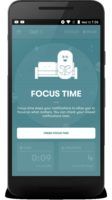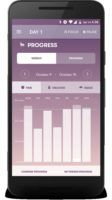The growing issue of smartphone dependency
The growing issue of smartphone dependency
Published by Gbaf News
Posted on October 16, 2018

Published by Gbaf News
Posted on October 16, 2018

Georgie Powell founder of SPACE app, a behaviour change programme, outlines the growing issue of smartphone dependency and how forward-thinking companies can help employees to engage with technology more meaningfully

Georgie Powell
When we use technology consciously it enables us to connect, create and learn. But for many, our smartphones have become a habit which causes us to miss out on meaningful engagement in the real world. We also miss the creativity that comes in idle moments, when our mind is free to wander.
This problem – using smartphones to the detriment of other aspects of our life – has been termed ‘nomophobia’ – a recognised psychological condition prescribed to people who sense fear or anxiety at the thought of being separated from their phone. Users are waking up to this condition.

Deloitte have found that almost two fifths of population perceive that they are using their device too much. This is significantly higher amongst 35-44 year olds (47%), 25-34 year olds (55%) and 16-24 year olds (56%). In the same report, Deloitte found smartphone behaviours are distracting users, harming their relationships with others and even potentially endangering their health or that of other people’s.
Independent research from SPACE, a digital wellness app, has found that amongst these groups, there is a strong sense of emotion associated with phones, with 28% of users feeling anxious if they are without their phone (compared with the 6% who feel happy).
DIGITAL DEPENDENCY IS IMPACTING PRODUCTIVITY
Businesses with their eye on the future, have started to recognise the impact the smartphone dependency is having in the workplace. In their recent report, Microsoft highlight how having a weak digital culture – one where technology is not deployed purposefully – can have significant negative effects on employee engagement, productivity and creativity. In their article, “is the economy suffering from the crisis of attention?” One of the key findings from a recent post on the Bank of England’s blog on productivity and smartphone usage (24 November 2017) was that we are more distracted than ever as a result of the battle for our attention.
Breaking out of habits is hard. Whilst the jury is still out on whether or not the term ‘addiction’ can be used to label our dependency on smartphones, the reality is that these habits are hard to break. Apps and services are built purposefully to keep us hooked. News feeds, notifications and content are designed to offer ‘variable rewards’. Like a slot machine, each unlock or swipe releases a small amount of dopamine in our brains, encouraging users to keep on coming back. Unchecked, and propelled by the power of big data and AI, these products are likely to become increasingly compelling as time goes by.

REGULATING OUR DIGITAL LIVES
However, change is afoot. Like many other social challenges which have
widespread health or productivity implications, such as smoking or obesity,
governments and regulators are starting to take steps to better define and
defend ‘rules of the road’ when it comes to smartphones. This has
particularly been the case in ASIA where there are fines for parents if
their under-8s become ill from excessive use (Taiwan), mandatory monitoring
of usage (South Korea) and traffic signs or cell phone lanes to avoid
collisions (Japan, China, South Korea).
Tech companies too are facing increasing pressure to admit to the addictive nature of their products and to evolve accordingly. In the past few months, Google, Apple, Facebook, YouTube and Instagram have all released features to allow users to monitor their screen time. But many say that whilst this is a step in the right direction, statistics alone are not enough to support behaviour change, particularly when these features are often buried deep within operating systems or settings. In the future, we expect to see increasing pressure from organisations like the Centre for Humane Technology, for technology companies to move away from the race for users attention towards more ethical forms of deeper engagement.

FINDING A PHONE/LIFE BALANCE
But perhaps most powerfully, we are seeing a rise in the number of users recognising their smartphone dependence and the impact it is having in their personal and professional lives. SPACE has been downloaded by millions of people looking to find their phone/life balance. It indicates that people have realised that their smartphone habits are having an impact on their life, be it at work or at home. Perhaps they are feeling anxious, missing out on sleep, or their phone use is starting to affect their relationships. Having been developed with input from leading universities and based on behaviour change principles, SPACE supports users as individuals or groups, on their journey towards a happier and healthier relationship with their phone.
In the workplace too, the corporate wellness market, estimated to be worth over $8 billion in the US alone, is starting to recognise the impact that phones are having on employee wellbeing, engagement and productivity. Companies like Shine Offline, are offering solutions to help companies think more purposefully about their use of technology in the workplace.

HR professionals and employees alike have a duty to themselves and their organisations to think more critically about their smartphone use and its effects. We recommend that they take conscious steps to put in place a strategy that outlines how phones and technology more widely should be used with purpose across an organisation. This may start with an open conversation throughout the organisation about how employees are currently feeling about their relationships with technology. It is then down to the organisation to put in place a program to support individuals and teams as they look to define their own rules of the road.
This is not just about smartphones and apps though. As technology becomes more pervasive – as our homes, cars and even bodies become connected, it will become increasingly important for us to know how to consciously connect. That’s why we need to work quickly to put in place guidelines for how we want to relate to technology.
Explore more articles in the Top Stories category











